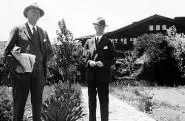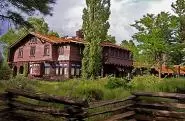The History of Riordan

Built in 1904 for Timothy and Michael Riordan and their wives and children, the Riordan Mansion is an impressive reminder of gracious living in a small, territorial logging town. Lovingly referred to as ‘the biggest duplex in town’, the historic mansion is an Arizona treasure — a remarkable example of Arts and Crafts style architecture featuring a rustic exterior of log-slab siding, volcanic stone arches, and hand-split wooden shingles. The expansive home has forty rooms, over 13,000 square-feet of living space, servant’s quarters, and regally sits atop Kinlichi Knoll in Flagstaff.
Designed by architect Charles Whittlesey, who was also the architect for the El Tovar Hotel at the Grand Canyon, the Riordan Mansion includes two nearly identical homes built for Michael and Timothy Riordan. The homes are connected by a rendezvous room known as the Billiard Room and the structure features indoor plumbing, hot and cold running water, central heat, and electric lights, reflecting the most modern technology and design of the time.
Timothy and Michael Riordan were members of a prominent Arizona family who played a significant role in the development of Flagstaff and northern Arizona and were involved in lumber, railroads, cattle, banking, and politics. The Riordan brothers continued on their family’s path and became prominent pioneer Flagstaff businessmen who developed a successful logging business, the Arizona Lumber and Timber Company. Moreover, the two brothers were known for their contributions within the Flagstaff community, which were essential to the development of the social and economic structure of Flagstaff and Northern Arizona.
As business leaders and the largest employers in Flagstaff, their priorities revolved around supporting the business and economic development of Flagstaff. In a new and growing frontier environment, this meant securing government services, attracting industry to diversify the economy, and making technological improvements for the community. In keeping with their Catholic faith, middle-class origins, and Progressive era values, it also meant establishing medical care, churches, schools, and the infrastructure needed for a healthy community. But perhaps the Riordan’s greatest accomplishment aside from their business was the creation of the Flagstaff reservoir. The reservoir’s Lake Mary, named after Timothy’s first daughter, was created in 1903 on land their company had purchased. What was initially considered to be a ‘test dam’ is still active today and provides 1/3 of the water used in Flagstaff.
In the 1980s, the extended Riordan family gifted the mansion and surrounding acreage to the city of Flagstaff and the Arizona State Parks system to be used a museum. Today, the history of Flagstaff and of the Riordan family is shared with thousands of visitors each year.
Check back next week as we explore the interior of this grand Arts and Crafts estate and learn more about the collection the Riordan families amassed throughout their time in Flagstaff!
Many thanks to Arizona State Parks and the Riordan Action Network for providing information and photographs.

